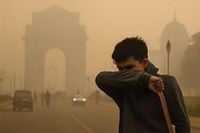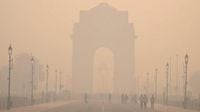On the morning of October 21, 2025, New Delhi awoke beneath a thick, gray blanket of smog—a now-familiar sight, yet no less alarming for its regularity. The cause? The annual Diwali festival, celebrated the night before with a dazzling (and deafening) array of fireworks, had once again sent air pollution levels soaring to hazardous heights, despite attempts to rein in the tradition’s environmental toll. According to IQAir, a Swiss air-quality monitoring organization, the city’s Air Quality Index (AQI) reached a staggering 442, making New Delhi the world’s most polluted major city that day.
For many residents, the morning after Diwali was marked not by joy, but by coughing fits, watery eyes, and a sense of resignation. The city’s air was thick with fine particles and chemicals, the result of millions of firecrackers ignited well into the night. “I have never seen anything like this before. We can’t see anything here because of pollution,” said Vedant Pachkande, a tourist visiting New Delhi, as quoted by the Associated Press. The city’s AQI, measured at over 350 in several neighborhoods, far exceeded the World Health Organization’s recommended daily maximum exposure, with PM2.5 concentrations recorded at more than 59 times the annual safety guideline.
PM2.5 refers to particulate matter measuring 2.5 microns or less in diameter—tiny enough to slip deep into the lungs and even the bloodstream, increasing the risk of respiratory and cardiac diseases. According to Reuters, India’s Central Pollution Control Board (CPCB) rated the city’s air quality as “very poor,” with an AQI of 350, while IQAir’s reading of 442 placed it firmly in the “hazardous” category. For comparison, the CPCB considers an AQI of 0-50 as good, and anything above 300 as “very poor” to “severe.”
Fireworks are a cherished part of Diwali, the Hindu festival of lights, which this year was celebrated from October 18 to October 23. But the tradition comes with a heavy environmental price. Fireworks contain oxidizers, fuels, and chemical additives that create vibrant colors and dramatic effects, but also release heavy metals, carcinogens, and fine particulates into the air. Research cited by Nation Thailand shows that fireworks can increase air pollution by up to 42% and raise PM2.5 concentrations tenfold. Many of these compounds are not only hazardous in the short term but can also have lasting effects on respiratory health.
Recognizing the dangers, India’s Supreme Court last week attempted to strike a balance between tradition and public health. The court relaxed a blanket ban on firecrackers, allowing the use of so-called “green crackers”—fireworks designed by federal research institutes to emit 30% to 50% fewer pollutants than conventional ones. These were permitted for three hours each on Sunday and Monday (October 19 and 20), but as in previous years, the rules were widely flouted. Reuters reporters and numerous witnesses observed fireworks being set off long outside the allotted times, a reality that undermined the court’s intentions.
New Delhi’s pollution woes are not limited to Diwali. Every winter, the city and its surrounding regions—home to more than 30 million people—find themselves shrouded in a toxic haze. Cold, stagnant air traps construction dust, vehicle emissions, and smoke from agricultural fires, compounding the effects of festival fireworks. The Ministry of Earth Sciences forecasted that air quality would remain “very poor to poor” in the coming days, with AQI levels expected to fluctuate between 201 and 400. As Al Jazeera noted, many of the city’s 20 million residents routinely struggle with respiratory illnesses during these months.
Authorities have not been idle in the face of this annual crisis. Measures such as limits on construction activity, restrictions on diesel generators, and even school closures have been implemented in the past to curb pollution. Private vehicle use has also been restricted during particularly bad spells. Yet, as environmentalists point out, these are stopgap solutions. Long-term progress, they argue, will require a shift to cleaner energy sources, stricter vehicle emission controls, and a concerted effort to address the burning of crop residue in neighboring states.
The problem doesn’t stop at New Delhi’s borders. Across the border in Lahore, Pakistan’s capital of Punjab province, air quality reached an AQI of 234 on the same day—second only to New Delhi, according to IQAir data. Pakistani authorities have launched an “emergency plan” to tackle pollution, which includes curbing farm fires, restricting smoke-emitting vehicles, and deploying anti-smog guns. “Right now, the major issue is the air coming from Indian Punjab and other parts, which is affecting the air quality in various parts of Pakistani Punjab,” said Sajid Bashir, a spokesperson for Punjab’s Environment Protection Agency, as reported by Reuters.
This regional crisis has global implications. A recent study published in Scientific Reports in October 2025 found that rising air pollution has reduced sunshine hours across much of India. “We see a greater impact in more polluted regions such as northern India,” said Manoj K. Srivastava, a scientist at Banaras Hindu University and one of the study’s authors, speaking to the Associated Press. The reduction in sunshine affects not only public health and the local environment but also the amount of solar power India can generate and the country’s agricultural productivity.
With each passing year, the urgency to find sustainable alternatives grows. Some countries have started to replace traditional fireworks with laser light shows and drone performances, offering spectacular yet environmentally friendly celebrations. While these innovations have yet to take hold in India’s Diwali festivities, they offer a glimpse of what the future could look like if environmental concerns are given their due weight.
For now, New Delhi’s residents are left to navigate the aftermath of another Diwali, balancing cultural tradition with the harsh realities of toxic air. The annual debate over fireworks and pollution continues, but so does the search for solutions that honor both heritage and health. As the smog lingers and the city waits for cleaner air, the question remains: how much longer can this cycle go on before real change takes root?



